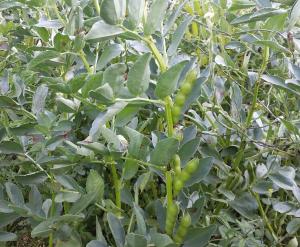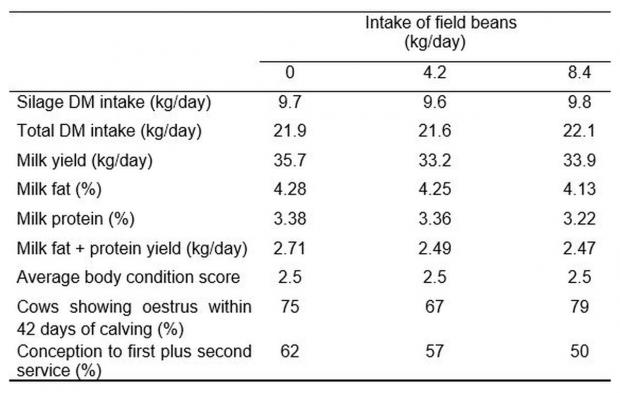As the milk yield potential of dairy cows has increased, so has the demand for concentrate feeds, and the high quality ‘protein’ ingredients that they contain.

However, many protein ingredients are imported from countries outside the European Union (EU), and this has left the dairy sector vulnerable to instability of supply and price volatility, the impact of which has the potential to increase in the current political climate. Consequently there is considerable interest in the use of locally-grown protein crops, including field beans.
While field beans have a moderate crude protein content (280 g/kg dry matter), they have a relatively high starch content (400 g/kg dry matter), and as such might appear to be ideal in ruminant diets. However, the inclusion of field beans in ruminant diets is normally restricted due to the perceived risk associated with ‘anti-nutritional substances’ that have the potential to reduce intakes and digestibility, and oestrogenic compounds that could adversely impact fertility.
Previous work at AFBI included 4.7 kg of field beans per day in the diet of mid lactation dairy cows and no adverse effects on performance were found. This represented a moderate inclusion rate and the current study, which was co-funded by AgriSearch and DAERA, took the concept further and examined the impact of including both moderate and high levels of field beans in the diet of freshly calved dairy cows.
The study
The study involved seventy early lactation dairy cows, offered a mixed ration of silage and concentrates (approximately 45 : 55 on a DM ratio). The concentrates contained either 0%, 35% or 70% field beans (representing daily intakes of beans of 0, 4.2 and 8.4 kg per cow, respectively). In the diet containing 8.4 kg beans, the beans replaced all of the soya bean meal, rape seed meal and maize gluten. All four concentrates had the same crude protein content (19.3% on a fresh basis), although starch levels were marginally higher when 8.4 kg of beans were included. The beans (variety Fuego) were sourced from a local farm, and dried to approximately 14% moisture content, before being milled and incorporated into the concentrates. The diets were offered to cows from calving until day 140 of lactation.
Outcomes
The effects of including field beans is presented in Table 1. The results clearly demonstrate that dairy cows were able to consume the diet which contained 8.4 kg beans per day with no negative effect on intakes. This suggests that the ‘anti-nutritional substances’ present in beans may not have as large an impact on intakes as previously thought.
However, while milk yield was not significantly affected, both milk fat and milk protein contents were reduced when offering the diet containing 8.4kg of beans, and as such, milk fat plus protein yield was also reduced.
While the reduction in milk fat content can likely be attributed to the high starch intake as a result of the high bean inclusion (8.4 kg), the reduction in milk protein content is more likely to reflect a shortage of specific amino acids in the diet.
For example, field beans are known to contain much lower levels of the amino acid methionine than either soya-bean meal and rapeseed meal, and methionine is known to be essential for milk protein synthesis.
Thus it is speculated that the reduction in milk protein content might have been avoided if the diet containing 8.4 kg of beans had been supplemented with specific amino acids such as methionine.
Nevertheless, the reductions in milk fat and protein content in the current experiment reduced the value of milk produced by approximately 80 pence/cow/day.
Regarding fertility performance, the inclusion of beans in the diet had no effect on days to first oestrus. However, conception rates tended to fall when the diet containing 8.4 kg of field beans was offered.
While very large numbers of cows are needed to identify genuine differences in fertility performance, the trend observed causes some concern regarding the inclusion of very high levels of beans in the diets of early lactation cows. Consequently, based on the results of the two studies undertaken to date, in order to manage the potential risks which field beans may present, it is recommended that field bean inclusion levels for dairy cows do not exceed 4.0 – 5.0 kg per cow per day.
This study is one in a series examining options for replacing imported protein feed stuffs with locally grown ‘protein’ sources. For example, a further study has examined the effects of post-harvest treatment of beans (preservation and processing of dried beans) on cow performance, and will be reported in the near future.

Latest news
- AFBI issues Nematodirus warning – Spring 2025 11 April 2025
- Managing Nature Based Risks to the UK Economy and Opportunities for Green Finance 08 April 2025
- AFBI Hillsborough host AERA committee 27 March 2025
- The Omics Days Conference 27 March 2025
